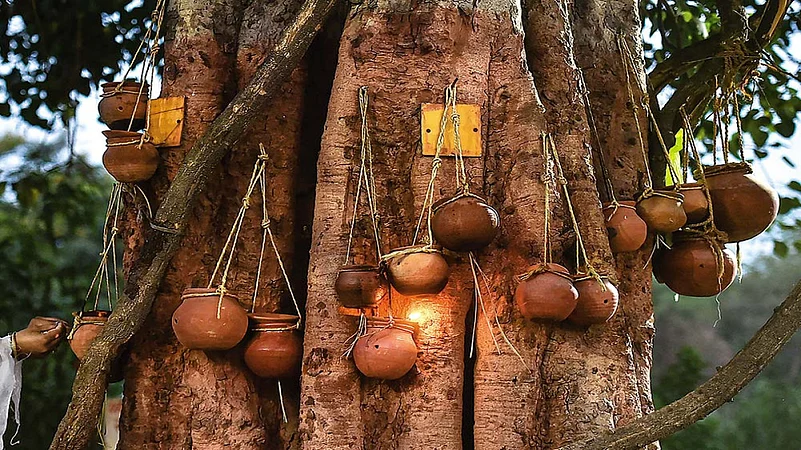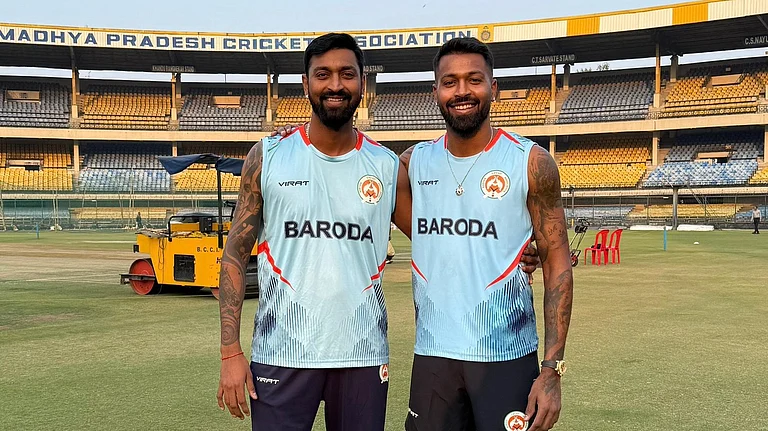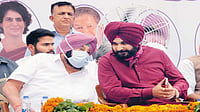The dead tell no tales, they say. But they do now. Macacbre stories. Of the dead and the dying. Stories from bloated corpses floating on the Ganga in Bihar’s Buxar or that of stray dogs feeding off bodies buried in shallow mass graves along the banks of the river in different towns of Uttar Pradesh. Gut-wrenching and heart-breaking stories that have left a grieving country seeking answers from a clueless political leadership, besides exposing human insensitivity and helplessness in the face of the great pandemic.
In Buxar, the district administration fished out 81 bodies from the Ganga, over three days, earlier this month. A report in Hindi daily Dainik Bhaskar says at least another 2,000 bodies were found in mass graves along the Ganga’s course in Uttar Pradesh over the past fortnight—900 in Unnao, 350 in Kannauj, 400 in Kanpur and 280 in Ghazipur. Were these people victims of the Covid pandemic that has been devouring lives with an insatiable appetite in India and the world for over a year now? The state of the corpses—most in late stages of decomposition—may make it difficult for any coroner to ascertain the exact cause of death. But the most obvious suspect here is the coronavirus, given the ferocity with which it is wreaking havoc in India’s hinterland, in remote villages and nondescript towns that often escape the attention of a system obsessed with metropolitan cities and state capitals.
ALSO READ: Marathwada: The Social Virus
The pandemic’s second wave has engulfed the country with a fierceness that has long surpassed the first wave, exposing critical shortcomings in the country’s healthcare, especially in rural India—the humiliating struggle to get treatment, the evasive oxygen cylinders, life-saving drugs and even hospital beds. The political and administrative apparatus is equally suspect in abetting the loss of these lives and denying them dignity in death. That the massive surge in fresh cases coincided with the recently concluded polls for five assemblies for which various political parties, and most notably the prime minister himself, organised super-spreader rallies throwing Covid precautions to the winds is no coincidence.
It was only days after the ghastly reports of mass graves and floating corpses, coupled with images of countless funeral pyres across crematoriums—several of them hurriedly built to cope with the astronomically rising death toll—and growing suspicions of India under-reporting its positivity rate and fatality data, that the Centre woke up. Straight out of its toolkit of bumbling post facto responses to the raging pestilence, the Centre, on May 16, issued guidelines to the states and Union territories for containing the pandemic in rural, peri-urban and tribal areas. The proposed measures included setting up oxygen cylinder-equipped makeshift Covid care centres at the village level and intensifying testing.
Official data on fresh infections and deaths has begun to show a significant drop since the new guidelines. UP CM Yogi Adityanath, who met a select group of journalists in Noida the same day that the Centre’s new blueprint was unveiled, even declared that the pandemic situation in UP was “not alarming or out of control”. Adityanath’s claim wasn’t usual political rhetoric—reported cases have indeed been declining in UP; they stood at just around 12,500 new cases on May 15 as against nearly 35,000 reported on April 30.
ALSO READ: Susegad With The CM
A similar trend is being witnessed elsewhere too. The true story of the infection’s spread, however, lies not in the officially released statistics that have been prone to criticism for obfuscation. Instead, the truth lies in the data not available for a combination of factors, including alleged under-reporting. Take, for instance, the reaction of Dr S. Senthilkumar, the DMK MP from Tamil Nadu’s Dharmapuri, to his state’s Covid data for May 14. The number of deaths registered for Dharmapuri district on that day was zero, yet bodies were waiting to be cremated or buried around the district. “On three other days in May the district authorities had declared zero deaths when people known to me personally had perished. I have doubts about the figures being touted by the district authorities,” says Senthilkumar, who is also a radiologist.
Senthilkumar refers to nearly 400 CT scans being done at three centres in Dharmapuri town daily (including one government hospital) confirming Covid. “Out of these, at least 80 per cent come from rural areas of the district, pointing to an alarming trend that the virus has found its way to villages. This means many deaths due to Covid could also be occurring back at homes in villages, which do not get accounted for in the official data,” he says.

A barricade being erected at Haryana’s Titoli village where 21 people died in April.
As of March 17, of India’s 741 districts, over 500 had a Covid positivity rate of over 10 per cent; but this is just the officially released figure. If the mayhem is anything to go by, the crisis runs far deeper. “Many people in the rural areas have lost their lives after developing Covid-like symptoms, but they were never tested,” says Ashok Kumar, a social worker in Bihar’s Muzaffarpur. In the state, rural areas and small towns account for 76 per cent of the cases, the third highest in the country. These areas had more or less escaped the wrath of the deadly virus last year when the infection was largely confined to big cities. A contributing factor in the infection’s spread has been the recent wedding season and the preceding Holi festivities. In Nalanda, a Covid-positive man passed away barely hours before his wedding. In Khudiya village of Munger district, a bride died within hours of the wedding—the groom performed her last rites.
Hundreds of miles away, in the hill state of Himachal Pradesh, it’s the same story. With 35,000 active cases as on May 17, against 218 reported in March, there’s hardly any part of the state that hasn’t recorded a fresh Covid case in the past fortnight—and there’s a palpable fear that official figures hide a grim reality. “In the villages, not everyone is keen on getting tested. Many people hide in their homes if they have symptoms fearing they might be ostracised if found positive,” says Sushila Chauhan, a healthcare worker in Chamba district. The state is also bearing the brunt for increased mobility over the past few months. Himachal receives heavy tourist traffic from Delhi, Haryana, UP and Punjab. Many of the state’s residents also work in various towns of Punjab that border Himachal and commute between the states daily. The ongoing farmer agitation across Punjab and Haryana has already plunged rural areas of the two states deep into the Covid abyss with protestors rarely observing any Covid precautions.
In Bapora village of Haryana’s Bhiwani district—Union minister V.K. Singh’s ancestral home—over 30 people have reportedly died in the past two weeks. Naresh Kumar, the village sarpanch, claims many of the deceased showed Covid symptoms though only three tested positive. In April, Titoli village in adjoining Rohtak district witnessed 21 deaths, but officials claimed only four of these were confirmed to be due to Covid.
Last month, the festival of Baisakhi in Punjab also saw massive crowds gathering for celebrations; a natural corollary was a steep rise of cases in places like Rupnagar, Fatehgarh Sahib, Amritsar, Ludhiana, Kapurthala and Tarn Taran. For Himachalis, this has been a double whammy. The Kumbh Mela in nearby Haridwar saw a huge number of Himachalis travelling for the religious congregation and then returning home, unaware that they brought the infection with them. “Many persons tested positive after returning from Kumbh. They did not follow Covid-appropriate behaviour and happily visited neighbours and relatives, thereby spreading the infection,” says Shimla deputy commissioner Aditya Negi. The mass political gatherings for municipal polls in Palampur, Dharamshala, Solan and Mandi too contributed to the surge in infections.
A similar pattern of festive revelry and election campaigns spelling doom has been replicated elsewhere in the country too. Prashant Sonowal, a resident of Nakhatgaon in Assam’s Dibrugarh district, cannot figure out how there are now 105 Covid cases in the 205 households in his village. At Dibrugarh’s Mayajan tea estate, Satish is grappling with the same question—the estate had been untouched by the infection during the last wave and now there are over 60 cases. Dr Biswajyoti Borkakoty, scientist and nodal health officer, tells Outlook that a serological survey revealed low prevalence of Covid in some areas since the last outbreak. “The data collected gave us reason to believe that the rural areas were still prone to the virus and if another wave came, then these areas will be hit more than their urban counterparts,” he said.
While the signs of an impending outbreak in Assam were clear, the political brass and the people ignored them when the state went to polls in April. “There is no corona in Assam and no need to wear a mask; if there is need to wear a mask, I will tell the people,” newly sworn-in CM Himanta Biswa Sarma declared, rather proudly, to a reporter. In Bengal, the state that saw an eight-phase assembly election spread over two months and marked by massive rallies by all stakeholders, including PM Narendra Modi and Union home minister Amit Shah, the situation is no different. In Birbhum district, as on May 17, there were 4,140 active cases compared to just 35 active cases reported exactly two months ago. In Nadia district’s Shaktinagar Zilla hospital, all 76 Covid beds were occupied at the time of writing, while at the Netaji Subhas Sanatorium hospital only 10 of the 301 Covid beds were vacant. The number of active cases in Nadia rose from 42 on March 17 to 6,935 on May 7—a 165-fold hike.
On March 17, just 10 days before the first phase of the Bengal assembly polls, the state had 3,188 active cases. Two months later, on May 17, the numbers had gone up astronomically to 131,560 active cases. CM Mamata Banerjee, who had earlier said she was against imposing a lockdown because it could hurt the downtrodden, announced a near-complete lockdown from May 17 to May 31.
An interesting case in contrast has been Kerala, another state that went to polls. Thanks to its robust public health infrastructure and a political establishment that seems to have learnt tough lessons from the devastation the state witnessed during the first wave, Kerala has managed to keep a low mortality rate despite the positivity rate in the second wave still being high. When the Centre unveiled its blueprint to tackle the epidemic in villages last week, Kerala had no surprises. The state has already been following a model of three-tier health infrastructure, linking makeshift facilities with primary and community health centres. “Kerala has an effective decentralised system where panchayats work like a semi-government and use their power effectively,” says Dr Mathews of the National Health Mission.
Ernakulam, the commercial capital of Kerala, was one of the first districts that implemented the three-tier system effectively, says district collector S. Suhas. The district, which has a high positivity rate, has gone into triple lockdown in addition to adopting stringent measures in view of the second wave. The district administration has tied up with Bharat Petroleum Corporation Limited (BPCL) to set up one of the largest Covid centres with 1,500 oxygen beds. Suhas says the grassroots panchayat system has played a crucial role in combating Covid.
Not all states, however, are fortunate to have the public health infrastructure that Kerala boasts of. And the crippling effect the lack of basic medical facilities has had on Covid counter-measures is evident everywhere—even in Delhi’s premier government-run and private medical institutes, scores of patients had to run from pillar to post to get oxygen cylinders, life-saving drugs and admissions. In Uttarakhand, where the Kumbh jamboree has, arguably, been the worst amplifier of Covid cases, locals have to travel for hours to even get to a primary health centre.
In Almora, for instance, Jitendra Devrari, 33, is the only microbiologist who, along with his team of four technicians at the Almora Medical College, has been working 16 to 20 hour shifts daily for the past six months to ensure collection and testing of Covid samples. Since the Kumbh, he says he is practically working 24x7 because “there are no other private testing facilities in and around Almora, and people with Covid symptoms have been steadily rising.” A local health worker in Ranikhet tells Outlook, “the situation has been going from bad to worse; official figures don’t represent even 20 per cent of the actual cases.… People don’t want to get tested, they don’t want to get vaccinated either, and when they display symptoms, they refuse to go to a hospital because of the long journey.” The health worker says that in event of a person with Covid symptoms dying while at home, the family does a quiet cremation at any secluded spot in the forests around Almora and the authorities don’t ask any questions.

Corpses being buried in the Ganga riverbank in Allahabad, UP.
In tribal-dominated and economically backward Jharkhand, the lack of adequate medical facilities is only one aspect of the Covid challenge. Though official data, as on May 17, suggests the pandemic is well under control in the state—only 2,507 new cases that day, ground realities are much starker. In various parts of the state, there are complaints of people showing symptoms like cold, fever, loss of smell and appetite, but refusing to get tested. The superstitious prefer to turn to witch doctors and sorcerers instead, and when a patient with Covid symptoms succumbs, a large crowd of mourners converges for the cremation. In one panchayat of Chatra district, a government worker engaged in the investigation of Corona cases found only 12 of the 75 people willing to undergo any test. In Lohardaga, 75 people have died of Covid while more than 6,000 people have been infected.
While various state governments have imposed lockdowns and Covid curfews of varying intensity, ground reports suggests the restrictions are often flouted with impunity. When Jharkhand’s Hemant Soren government began issuing e-passes for necessary travel during the lockdown, 11,000 applications came from outside the state within the first two days, while 1.5 lakh people sought permission for inter-state travel. In Madhya Pradesh, the long border with UP and a poorly implemented curfew within the state has meant almost no real restrictions on travel. As a result, cases have been skyrocketing amid usual rumours of official data hiding the actual Covid count. The real story, as is unfortunately often the case, is unfolding at the crematoriums. In Bhopal, earlier this month, while cremations done as per Covid protocols touched a daily high of as many as 135, official death toll rarely ever crossed 20. Similar anomalies have been witnessed in other districts of MP, including Indore, Hoshangabad, Singrauli, Rewa and Chhatarpur.
As if all this isn’t frightening enough, there’s also the issue of people fearing retribution from the government for calling out lack of Covid management amenities and administrative failures. A social worker in Allahabad tells Outlook, requesting anonymity, “The Adityanath government is claiming everything is under control; other chief ministers are doing the same.… Travel anywhere in eastern UP and you will know how bad the situation is.”
Evidently, there is havoc in the hinterland. You don’t need dead bodies floating in the Ganga to tell you that.
***
The Kerala Three-Tier
Preetha Nair
This is one beast that cannot be tamed, defeated or vanquished—a formidable adversary that can only be contained. Kerala understood the importance of containment when the novel coronavirus bore down on the planet last year. The state could draw from its experience in handling the Nipah outbreak in 2018—another pathogen, more contagious than Covid. Isolation of patients, testing and contact tracing—protocols as old as sanatoriums for tuberculosis—were followed meticulously. The state’s primary health system rose up to the occasion and delivered. Together, they kept the Covid count low and became a role model for others to follow. But then, Covid is Covid—mutating into variants deadlier than the first, hunting down hosts at a pace we thought impossible. The second wave—like those death roll Act Twos of past pandemics—barreled down on India, catching people and administrations off guard. Kerala couldn’t escape the burst, and the second surge entered its boondocks, backwaters and villages too. Yet, the state has been able to stave off a high death count. How and why?
Experts attribute Kerala’s success to its health infrastructure and decentralised public health system. Kerala has been following a three-tier health infrastructure model linking makeshift facility with primary and community health centres. Dr Mathews of the National Health Mission says: “We have no urban-rural divide here. Kerala has an effective decentralised system. Under this, panchayats work like a semi-government and they use their power effectively. The three-tier system is in place since the pandemic hit.”
A case in point is Ernakulam, the commercial capital of Kerala. It is one of the first districts that implemented the system effectively to contain the spread of the virus, says district collector S. Suhas. The district, which has a high positivity rate, has gone into triple lockdown in addition to adopting stringent measures in view of the second wave. The district administration has tied up with Bharat Petroleum Corporation Limited (BPCL) to set up one of the largest Covid centres with 1,500 oxygen beds. To streamline operations with its 82 panchayats, the district administration has introduced a war room that keeps track of hospital resources such as beds and oxygen.
V.S. Akbar, president of Mulavukadu panchayat, located a few miles from Ernakulam, says the district administration and the grassroots units work in perfect tandem. While timely tests and home-care support is provided through public health centres (PHCs), any critical patient is routed to the central team. “If a villager faces any problem, he calls me directly, even if it’s midnight,” Akbar says.
By Puneet Nicholas Yadav with inputs from Giridhar Jha, G.C. Shekhar, Ashwani Sharma, Dipankar Roy, Snigdhendu Bhattacharya, Preetha Nair, Harish Manav, Shamsher Singh and Navin Kumar Mishra


























